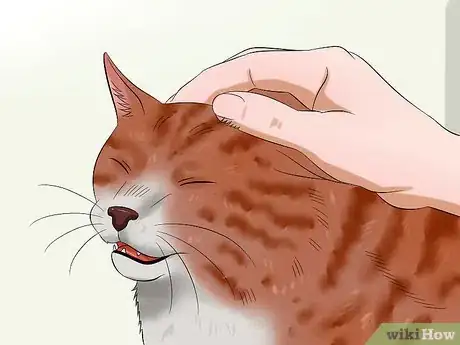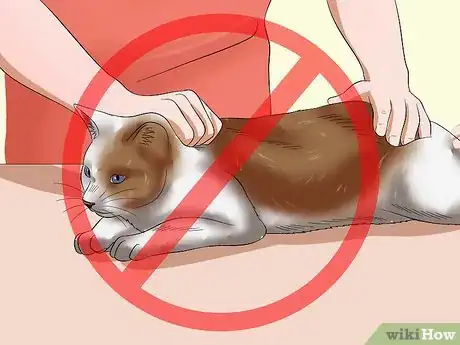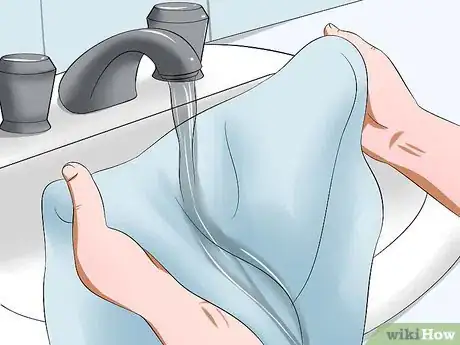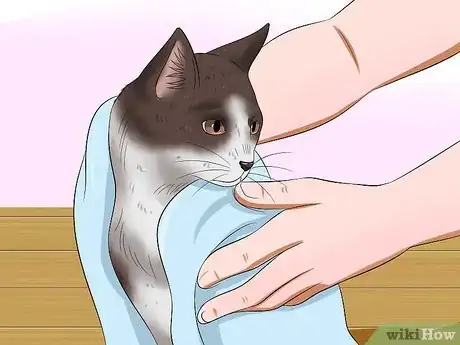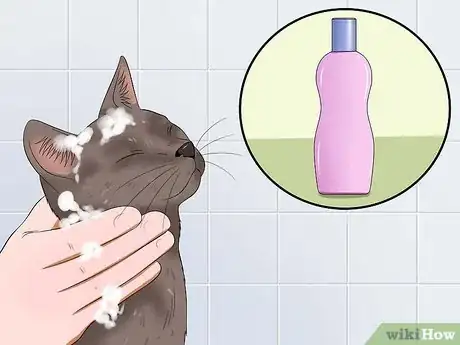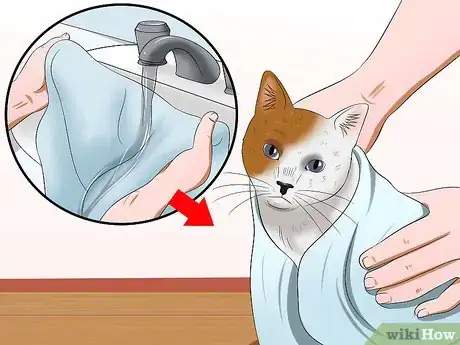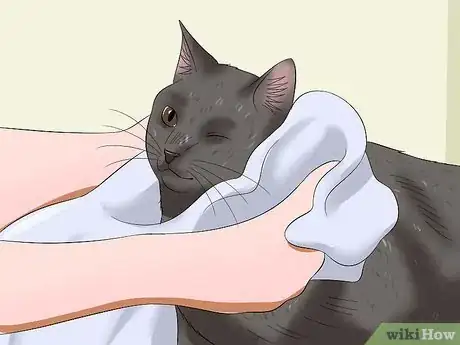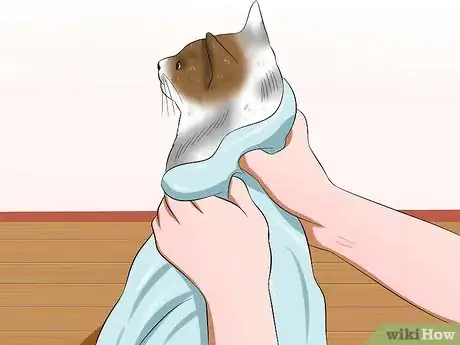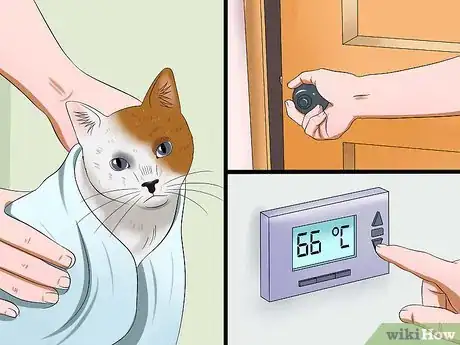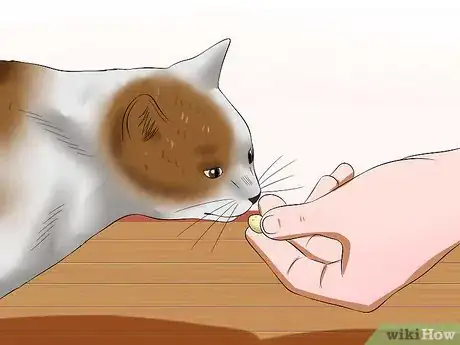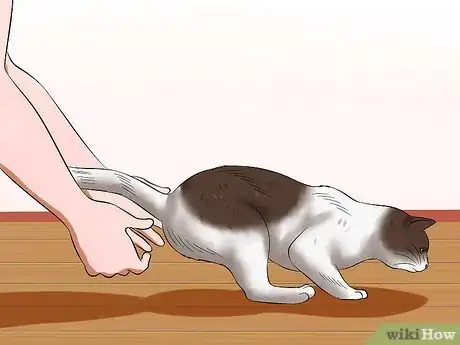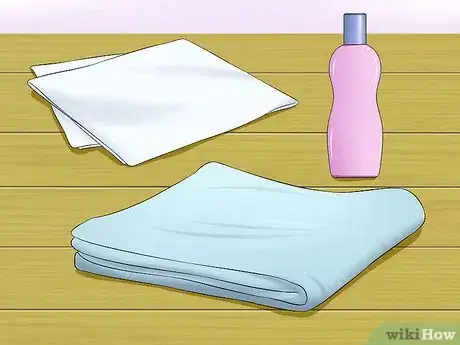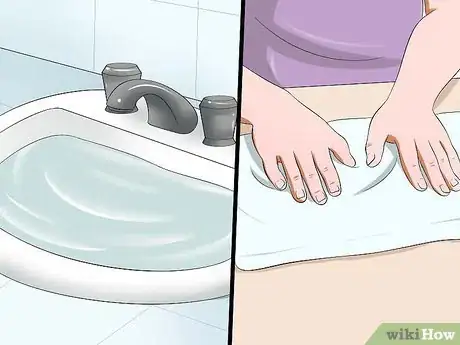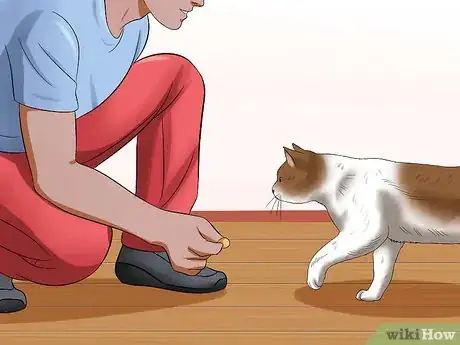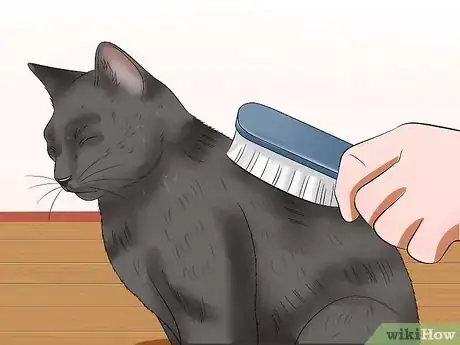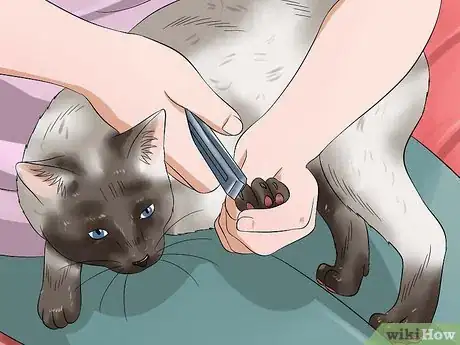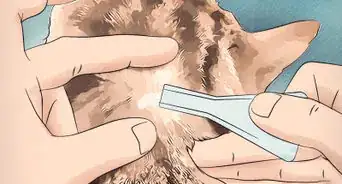This article was co-authored by Brian Bourquin, DVM. Brian Bourquin, better known as “Dr. B” to his clients, is a Veterinarian and the Owner of Boston Veterinary Clinic, a pet health care and veterinary clinic with three locations, South End/Bay Village, the Seaport, and Brookline, Massachusetts. Boston Veterinary Clinic specializes in primary veterinary care, including wellness and preventative care, sick and emergency care, soft-tissue surgery, dentistry. The clinic also provides specialty services in behavior, nutrition, and alternative pain management therapies using acupuncture, and therapeutic laser treatments. Boston Veterinary Clinic is an AAHA (American Animal Hospital Association) accredited hospital and Boston’s first Fear Free Certified Clinic. Brian has over 19 years of veterinary experience and earned his Doctor of Veterinary Medicine from Cornell University.
There are 8 references cited in this article, which can be found at the bottom of the page.
This article has been viewed 86,620 times.
Washing a cat is perhaps one of the most difficult things a cat owner might have to deal with. This is largely because cats like to take care of their own cleanliness and hygiene, and are averse to being completely cleaned by their human companions. As a result, most cats don’t respond well to taking a bath. Luckily, though, there are other ways of cleaning cats that don’t require completely soaking your poor friend. These methods will save you from potentially dozens of scratches and save your feline friend from a horrible experience.
Steps
Washing Your Cat
-
1Keep your cat calm. It's likely that after you catch your pet, she'll be pretty nervous, anxious, and might just fight for her life to escape your clutches. You need to do everything you can to calm and sooth your cat. This will save you from cuts and scratches, and make future baths easier affairs.
- Pet and rub your cat.
- Give your cat a treat.[1]
- Use verbal positive reinforcement, tell her that she is a "good kitty."
-
2Don't restrain your cat, unless they really need to be cleaned. Cats are good self-cleaners. If your cat violently opposes her bath, and is relatively clean, you might want to reconsider. It could turn out to be a costly bath for you in terms of cuts, and a traumatic experience for your cat. Consider:
- The length of your cat's coat.
- Environment -- is your cat an indoor or outdoor cat?
- Self-grooming behavior. Does your cat already take care of grooming adequately.[2]
Advertisement -
3Dampen a towel with lukewarm water. The towel should be wet, but not dripping, and the water should be warm, but not hot. You don’t want to wipe down your cat with a cold, wet towel. Make sure to do this in a slow and calm manner, as to not scare your cat.[3]
-
4Dab and blot your cat systematically. Move from her neck to her tail with your warm damp towel and slowly dab and wet your cat. Wash her head last, and with extra care. Make sure to go slowly and to not spook your cat.
- Make sure to re-wet the towel when appropriate.
- Start with a small wash rag for the rear area.
- Use another towel when you're done with the rear area, as to not spread fecal matter.
- Pay special attention to the rear area, especially on kittens. This area is often cleaned by a mother cat, and if she’s not around, you’ll have to give your kitten extra care.
- Make sure you clean your kitty’s belly, although they won’t be happy with this.
- Make sure to clean her armpits and in between her toes.
- As you approach your cat’s head and face, move slowly and don’t be rough.[4] [5]
-
5Decide if you want to use shampoo. This is up to you. Often times, shampooing cats is not necessary. You should also avoid using shampoo with kittens, unless they have fleas or the vet recommends it. If you do use shampoo, do so after you’ve already rubbed your cat down with the damp towel and wet her already.
- Fill a sink with water and put a little bit of shampoo in the water. Make sure that you don’t have many suds.
- Mix the water.
- Dip a fresh towel in the sink and dampen it with the shampoo water.
- Rub down your cat with the shampoo, beginning at her neck and moving toward her tail.
- Pay special attention to in between toes, under the belly and armpits, and her rear.
- Use a clean wash rag for extra dirty areas.
- Avoid contact with your cat’s eyes.[6] [7]
-
6Rinse your cat. Rub your cat down with a towel dampened only with water again. This is important because you don't want your kitty walking around with shampoo still in her coat. You need to be diligent in this process, as prolonged exposure to shampoo could cause irritation. Consider the following:
- Use a towel dampened with lukewarm water to rub your cat down and remove the shampoo and suds from your cat.
- Repeat this step until you are confident all of the shampoo has been removed.
- If you see any suds, you need to continue rinsing.
Drying Your Cat
-
1Take a towel and dab your cat until relatively dry. Don’t surround your cat with a towel at first – this might prove traumatic. Simply begin dabbing your cat dry, starting at her tail and moving toward her head. Remember, you want this to be the least traumatic of an experience possible. Work toward the goal of getting your cat used to and comfortable with her bath!
-
2Wipe down your cat’s fur. If your cat is comfortable with this, you can try a more direct approach by surrounding her with a towel and rubbing her dry. Make sure to do so gently, and if your cat responds negatively by being covered by the towel or being rubbed with it, back off and go back to dabbing her.
- Wipe gently.
- Wipe slowly.
- Wipe in the direction of her fur, the way she would lick herself. By following the grain of her fur you will make her feel more comfortable.[8]
-
3Prepare to release your pet, but don't do it yet. Make sure your house is ready for your cat to be released. Make sure no exterior doors are open. Make sure your home is a neither hot nor cold. You don’t want to release your cat into a house that is very hot or very cold. Check your thermostat before releasing your cat.
-
4Give your cat a treat. Before you release your cat, make sure to love on your cat and give her a treat. It is important that you give her a treat in the room she’s been bathed in, as she hopefully will see this as a positive experience. The more positive you are during and after the bath, the less traumatic it will be next time.
-
5Release your cat. After you release your cat, monitor her for a couple hours afterwards. Do this especially if it is cold outside or the temperature fluctuates in your home. You don’t want your cat becoming ill or coming down with a cold. In addition, tell her she's a "good kitty" as she's walking (hopefully not running) away from you.
Preparing for the Wash
-
1Set aside soft towels and other supplies you're going to need. You're not going to want to go running through the house during the bathe, and you certainly don't want to be looking for a towel when you need to dry your cat, so make sure you've got everything ready. This will help create a more seamless and less traumatizing experience for your cat.
- One large and soft towel for the initial wipe/wash down.
- Two or three soft wash clothes for extra dirty areas on your cat.
- One large and soft towel for drying.
- Shampoo, if you choose to use it.
- Use an extra towel if you plan to use shampoo.
-
2Find a suitable location. You need to find the perfect location to wash your kitty. It should be relatively warm, small, and safe. Your cat should also feel comfortable there. Consider:
- You should have access to a sink.
- The area should be neither too hot nor cold. Preferably between 72 and 76 degrees.
- The area should be relatively small and enclosed so that your cat can’t escape. Bathrooms and laundry rooms are often ideal locations.[9]
-
3Prepare the washing room. Gather everything you'll need before hand, and do everything you can before you bring your cat into the room. Things like running a sink, and going in and out of a bathroom while your cat is detained will just cause undue anxiety for the detainee. You don’t want to spook your cat or cause anxiety for no reason. Consider the following:
- Make sure not to have running water on when your cat comes to you.
- Pre-fill a sink with water.
- Pre-dampen a towel.
- Have treats or toys on hand to help relax your pet.[10]
-
4Capture your pet, but do it at an appropriate time. When detailing your cat for the bath, do everything you can to make it a calm experience. If you can, call your cat into the room in which you’ll be washing him or her, rather than bringing her in by force. Consider the following:
- Avoid chasing after your cat to bathe her.
- Don't pick a busy time of the day, like when everyone is coming home from school or work, to wash the cat.
- Use treats and positive reinforcement to lure your cat into the washing room.[11]
-
5Comb and groom your pet. Before you begin the process of wetting poor kitty, make sure to properly comb her in order to remove any loose hair or dirt from her coat. This is one of the first important steps in the bathing process, and will save you time and help produce a cleaner kitty.[12]
-
6Trim your pet's claws.[13] Even the most docile, sweet kitty can do serious damage when she is anxious and trying to get away from you. Trimming kitty's claws can reduce the blood-letting of not only her human, but of herself whenever her claw gets caught in something. Take this opportunity to reduce the damages done to furniture. It is extremely important that you are careful during this step ; as there are Blood Vessels running through the middle of each kitty's claw called the Quick . Cutting this part of the claw can cause excessive bleeding . (NB: Declawing is amputating the front part of a cat's toes and is highly-discouraged). Trimming kitty's claws will spare you from walking away from this bath with dozens of cuts.
Expert Q&A
-
QuestionWhat kind of treats can I use to make bathing my cat easier?
 Brian Bourquin, DVMBrian Bourquin, better known as “Dr. B” to his clients, is a Veterinarian and the Owner of Boston Veterinary Clinic, a pet health care and veterinary clinic with three locations, South End/Bay Village, the Seaport, and Brookline, Massachusetts. Boston Veterinary Clinic specializes in primary veterinary care, including wellness and preventative care, sick and emergency care, soft-tissue surgery, dentistry. The clinic also provides specialty services in behavior, nutrition, and alternative pain management therapies using acupuncture, and therapeutic laser treatments. Boston Veterinary Clinic is an AAHA (American Animal Hospital Association) accredited hospital and Boston’s first Fear Free Certified Clinic. Brian has over 19 years of veterinary experience and earned his Doctor of Veterinary Medicine from Cornell University.
Brian Bourquin, DVMBrian Bourquin, better known as “Dr. B” to his clients, is a Veterinarian and the Owner of Boston Veterinary Clinic, a pet health care and veterinary clinic with three locations, South End/Bay Village, the Seaport, and Brookline, Massachusetts. Boston Veterinary Clinic specializes in primary veterinary care, including wellness and preventative care, sick and emergency care, soft-tissue surgery, dentistry. The clinic also provides specialty services in behavior, nutrition, and alternative pain management therapies using acupuncture, and therapeutic laser treatments. Boston Veterinary Clinic is an AAHA (American Animal Hospital Association) accredited hospital and Boston’s first Fear Free Certified Clinic. Brian has over 19 years of veterinary experience and earned his Doctor of Veterinary Medicine from Cornell University.
Veterinarian Though cats are not as food-motivated as dogs, you can use treats such as Pounce, Greenies, little sardines, or pieces of fish.
Though cats are not as food-motivated as dogs, you can use treats such as Pounce, Greenies, little sardines, or pieces of fish.
Warnings
- Try to avoid using soap on your cat. If you feel you should be using soap, purchase some proper cat-specific soap from your local pet-care shop.⧼thumbs_response⧽
- If it is cold weather and you have an outdoor cat, don't let it outside until it is fully dry, it may get too cold and become sick.⧼thumbs_response⧽
- This method is best used for indoor cats. If you have a rescue cat that's been living outside for an extended period of time, you might want to consider a full water bath!⧼thumbs_response⧽
References
- ↑ Brian Bourquin, DVM. Cat Behavior Trainer. Expert Interview. 20 December 2019.
- ↑ http://www.banfield.com/pet-health-resources/pet-health-concerns/other-concerns/should-i-bathe-my-cat
- ↑ http://www.peteducation.com/article.cfm?c=1+2128&aid=1059
- ↑ http://www.howtocleanstuff.net/how-to-wash-a-kitten/
- ↑ http://www.peteducation.com/article.cfm?c=1+2128&aid=784
- ↑ http://www.aspca.org/pet-care/cat-care/cat-grooming-tips
- ↑ http://www.peteducation.com/article.cfm?c=1+2128&aid=784
- ↑ http://www.howtocleanstuff.net/how-to-wash-a-cat-2/
- ↑ http://www.catster.com/lifestyle/bathe-cat-care-without-bloodshed
- ↑ Brian Bourquin, DVM. Cat Behavior Trainer. Expert Interview. 20 December 2019.
- ↑ Brian Bourquin, DVM. Cat Behavior Trainer. Expert Interview. 20 December 2019.
- ↑ http://www.peteducation.com/article.cfm?c=1+2128&aid=1059
- ↑ Brian Bourquin, DVM. Cat Behavior Trainer. Expert Interview. 20 December 2019.
About This Article
To bathe your cat with a damp towel, start by running a large towel under lukewarm water and squeezing out any excess so it’s not dripping. Using the towel, slowly dab and blot your cat starting at its neck and moving towards its tail. Leave its head until last, and use a smaller towel for the rear area since you don’t want to spread fecal matter. When you’ve finished cleaning your cat, use a fresh towel to dab from tail to head until it is relatively dry. Before you release your cat into your home, give it a treat so it begins to view baths as a positive experience. For more advice from our Veterinary co-author, including how to keep your cat calm before a bath, keep reading!
